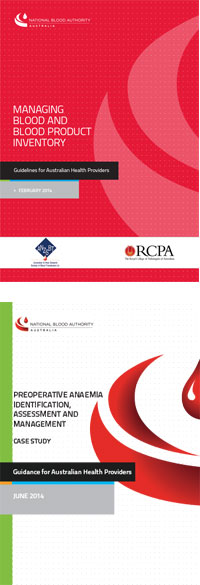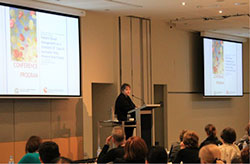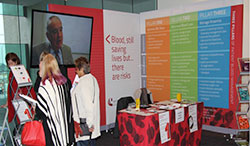Objective 3. Promote the safe and efficient use of blood and blood products
In 2013-14, the NBA increased its efforts to promote the safe and efficient use of blood and blood products, including the delivery of a range of key reference material and accelerated supporting implementation activities in relation to reducing wastage and improved fresh blood use based on the NBA developed Patient Blood Management (PBM) Guidelines.
Reference Development
In 2013-14, the NBA focused reference development on progressing Modules 5 and 6 of the PBM Guidelines and new National Haemophilia Guidelines. The NBA also completed a review of the process for updating the PBM Guidelines, scheduled to commence for the first modules in 2015. The NBA will seek to optimise the efficiency and timeliness of the Guideline updating process.
PBM Guidelines
Over 100,000 copies of the PBM modules 1 to 4 have been either issued in hard copy or downloaded in over 60 countries. They provide evidence based guidance on optimisation of the patient’s own blood, non-transfusion strategies to minimise blood loss and bleeding and strategies to manage anaemia. In 2013-14 the NBA progressed the development of the PBM Guidelines: Module 5 Obstetrics and Maternity and Module 6 Paediatric and Neonatal. The public consultation draft of Module 5 was provided to the National Health and Medical Research Council (NHMRC) and is expected to be published in early 2015. Module 6 progressed to the Clinical/Consumer Reference Group examination of evidence related to the first of four questions. Module 6 is scheduled for publication in 2016.
National Haemophilia Guidelines
The NBA has worked closely with the Australian Haemophilia Centre Directors’ Organisation (AHCDO) during 2013-14 to progress the new National Haemophilia Guidelines to replace the existing Clinical Practice Guidelines for the Use of Recombinant and Plasma- Derived Factor VIII and Factor IX products published in 2006. The revised guidelines will provide more comprehensive, patient-focused guidance to support the management of patients with haemophilia. The revised guidelines are expected to be published in 2015.
Implementation
A core element of ensuring reference material influences the safe and efficient use of blood and blood products are activities that support their implementation. In 2013-14, the NBA accelerated activities to support implementation of measures to reduce wastage of blood and improve appropriate use through PBM as defined in the JBC approved National Blood and Blood Product Wastage Reduction Strategy 2013-2017 and the National Patient Blood Management Guidelines Implementation Strategy 2013-2017. The strategies address a significant proportion of requirements identified in the 2010 Australian health ministers’ Statement on national stewardship expectations for the supply of blood and blood products. Although the strategies differ in terms of specific outcomes, the strategies share key common elements including the development of:
- best practice tools
- promotional and communication activities
- supporting education and training
- data to support implementation of improvement.
Best practice tools

In 2013-14 the NBA intensified its development of best practice tools to support health providers to implement improvements in the management and use of blood and blood products, including development of:
- guidance for the implementation of a PBM programme
- materials for the implementation of a single unit policy
- guidance for the provision of intraoperative cell salvage
- a guidance module for inter-hospital transfers as part of the Managing Blood and Blood Product Inventory Guidelines for Australian Health Providers
- guidance on acute transfusion reaction, recognition and management chart
- red blood cell and massive transfusion protocol clinical audit tools
- a case study on preoperative anaemia identification, assessment and management
- a case study on the Prince Charles Hospital implementing point of care testing
- promotional products for use within hospitals to raise awareness of wastage of blood and blood products.
Promotion and communication
With the increased focus on appropriate use of fresh blood products, opportunities to promote the guidelines and NBA’s key messages at conferences and sector events were leveraged in 2013-14. Through trade stands, presentations or conference advertising, NBA initiatives were promoted at the following key events:
- Australian Society of Anaesthetists National Scientific Congress, Canberra, September 2013
- Australian and New Zealand Intensive Care Society (ANZICS) Annual Scientific Meeting, Hobart, October 2013
- 2013 Annual Scientific Meetings of the Haematology Society of Australia and New Zealand, Australian & New Zealand Society of Blood Transfusion and the Australasian Society of Thrombosis and Haemostasis (HAA), Gold Coast, October 2013
- Australian Private Hospitals Association (APHA) 33rd National Congress, Melbourne, March 2014
- Combined Royal Australian College of Surgeons (RACS) Annual Scientific Congress and Australian and New Zealand College of Anaesthetists (ANZCA) Annual Scientific Meeting, Singapore, May 2014
- World Federation of Haemophilia Congress, Melbourne, May 2014
- Blood Service Transfusion Update, Melbourne, May 2014
The NBA also sponsored a number of stand-alone events designed to improve awareness and understanding of improvements required in the management and use of blood and blood products.
- The NBA engaged the Australian Commission on Safety and Quality in Health Care (ACSQHC) to co-brand a series of National Blood Symposiums held in September 2013 in Sydney, Melbourne and Adelaide. The symposiums, attended in total by more than 650 health professionals, were focused on supporting the implementation of Standard 7 Blood and Blood Products of the National Safety and Quality Health Service Standards (NSQHS).
- The NBA joined the Western Australian Department of Health to co-sponsor the inaugural National Patient Blood Management Conference, titled "Patient Blood Management as a standard of care in Australia: Past, Present and Future". The conference agenda included presentations from a cross section of international, national and local experts. The conference was acclaimed by over 300 attendees as highly successful with a strong demand for further events focused on PBM.
In 2013-14 members of the NBA Clinical/Consumer Reference Group presented on the PBM Guidelines at numerous international, national and local meetings.
Education and Training
National Blood Sector Education and Training Strategy
With the publication of the PBM Guidelines and the implementation of Standard 7 Blood and Blood Products, the demand for supportive education, training and information resources has risen.
In 2013-14, the NBA developed the JBC approved National Blood Sector Education and Training Strategy 2013-2016. The strategy outlines a plan to work with current education and training providers to address the growing demand for high quality, well-tailored education, training and health promotion materials to support the implementation of evidence-based practice and attainment of health service accreditation under the new standards.
BloodSafe eLearning Australia
BloodSafe eLearning Australia is funded by all Australian governments. The online site offers a range of courses relating to clinical transfusion practice including PBM, blood specimen collection and product handling. The suite of courses has proved to be very popular with 252,217 registered users and 65,284 new registrations in 2013-14. On average the site attracts about 5,500 new registrations and 10,500 course completions per month.
There were 31 per cent repeat registered users during 2013-14 demonstrating that existing users continue to return to the site to participate in new educational offerings.
The following enhancements were made to BloodSafe eLearning Australia during 2013-14:
- release two new modules, one on PBM and one on Perioperative which was based on the NBA’s Perioperative module of the PBM Guidelines
- update of the website to improve access including compatibility with mobile devices at www.bloodsafelearning.org.au
- Critical Bleeding and Postpartum Haemorrhage courses recognised as an emergency response activity for ANZCA Continuing Professional Development programme
- review of the Iron Deficiency Anaemia module in response to clinical feedback
- commencement on the development of a new module based on Module 4 Medical of the PBM Guidelines.
National Safety and Quality Health Service Standards
As part of the National Health Reforms, the ACSQHC has developed the NSQHS Standards. These standards are intended to drive improvement in safety and quality for patients. They also provide a clear statement of the level of care consumers can expect from health services. Accreditation against the standards commenced in January 2013. The NBA is committed to supporting health service organisations meeting the requirements under Standard 7 Blood and Blood Products. During 2013-14 the NBA worked with the Commission and other stakeholders to develop resources to support implementation of the Standard.
At the request of the Commission, the NBA also led a second series of webinars in October 2013 to provide an overview of the expectations outlined within Standard 7.
June 2014: Inaugural Patient Blood Management Conference


The Western Australian Department of Health and the NBA co-sponsored the inaugural Patient Blood Management (PBM) conference in Perth on 20-21 June 2014. The conference, entitled "Patient Blood Management as a standard of care in Australia: Past, Present and Future", included both International and Australian speakers.
The international speakers were: Stephan von Haehling from Berlin whose primary research interest is iron deficiency and cardiac failure; Michael Lill from Cedars-Sinai whose research interests focus on myelodysplastic syndrome and Axel Hoffmann who presented on "what is the cost of a blood transfusion?"
The Australian speakers, all PBM champions in their own right, presented on topics such as anaemia management and treatment, cardiac surgery, orthopaedic surgery, paediatrics, gastroenterology research, preoperative patient screening and scheduling, intraoperative cell salvage, goal directed therapy for managing coagulopathies, data and the tensions for PBM between a patient focus and a product focus.
The conference had 315 enthusiastic registrants and the audience comprised clinicians, nurses and pathology providers from the public and private sectors as well as representatives from consumer organisations, government and sponsors. The evaluation feedback received from the attendees was very positive with many suggesting the PBM conference should become an annual event.
Research and Development
National Blood Sector Research and Development Priorities
Under the National Blood Agreement the NBA is charged ‘…to facilitate and fund appropriate research, policy development or other action in relation to new developments by relevant government or non-government persons or bodies.’ In 2012-13 NBA worked with stakeholders to release the National Blood Research and Development Strategic Priorities 2013-2016. The purpose of the publication is to provide a useful resource to guide priority setting for research. It may be used by researchers to support funding requests, by identifying that their research aligns with priorities communicated by governments.
In 2013-14 the NBA partnered with the Transfusion Outcomes Research Collaborative (TORC) on a successful NHMRC project grant application to improve outcomes for patients with critical haemorrhage requiring massive transfusion. The project is consistent with the national research and development strategic priorities in that it seeks to:
- systematically measure and monitor transfusion practice and outcomes in patients with critical bleeding requiring massive transfusion. This will be achieved using data generated by the bi-national expansion of the Massive Transfusion Registry (MTR), which has already been successfully piloted at six Australian sites
- provide robust national data on blood utilisation for massive transfusion to inform blood supply planning and inventory management and thereby improve equity of access to blood products
- inform development of future clinical studies of patients with critical bleeding and provide a mechanism to support and measure translation of new findings into practice.

